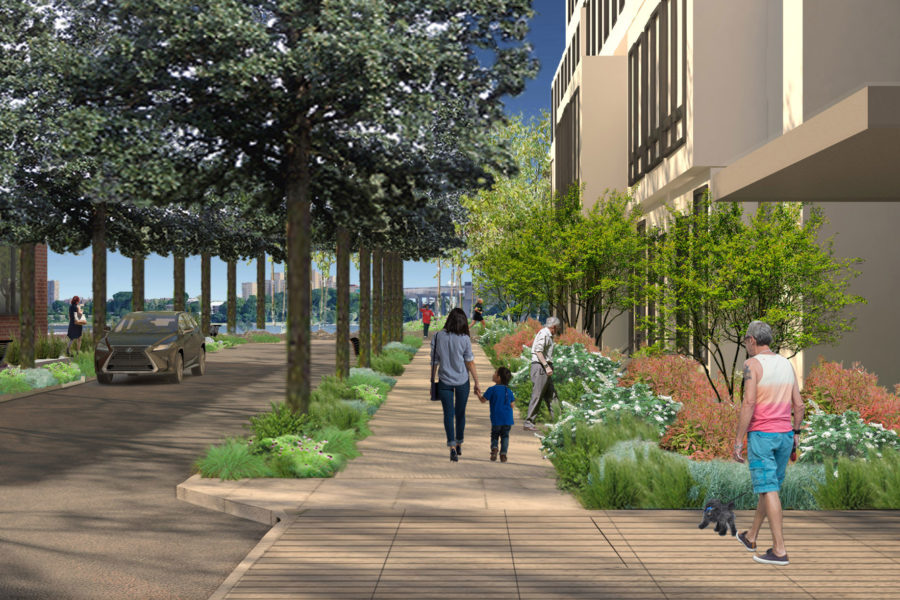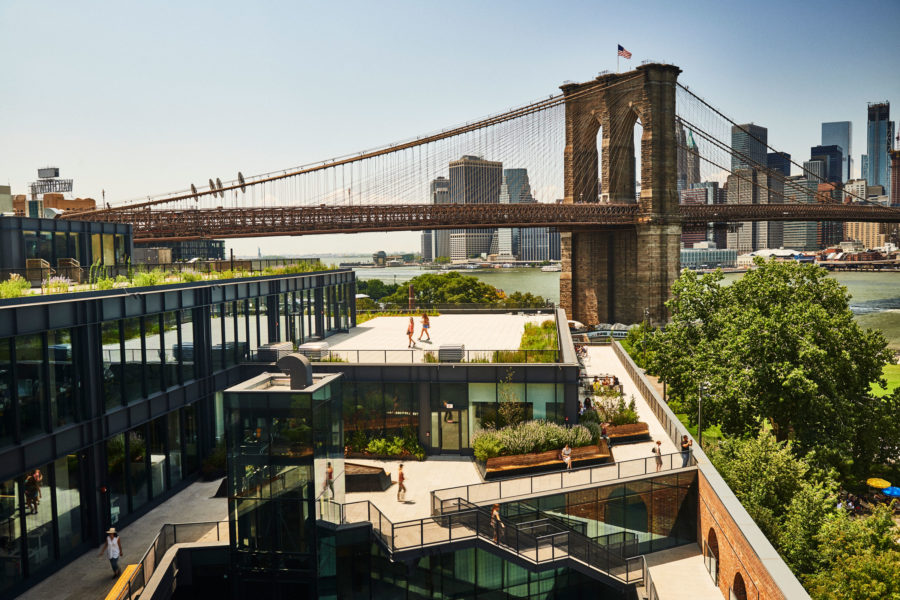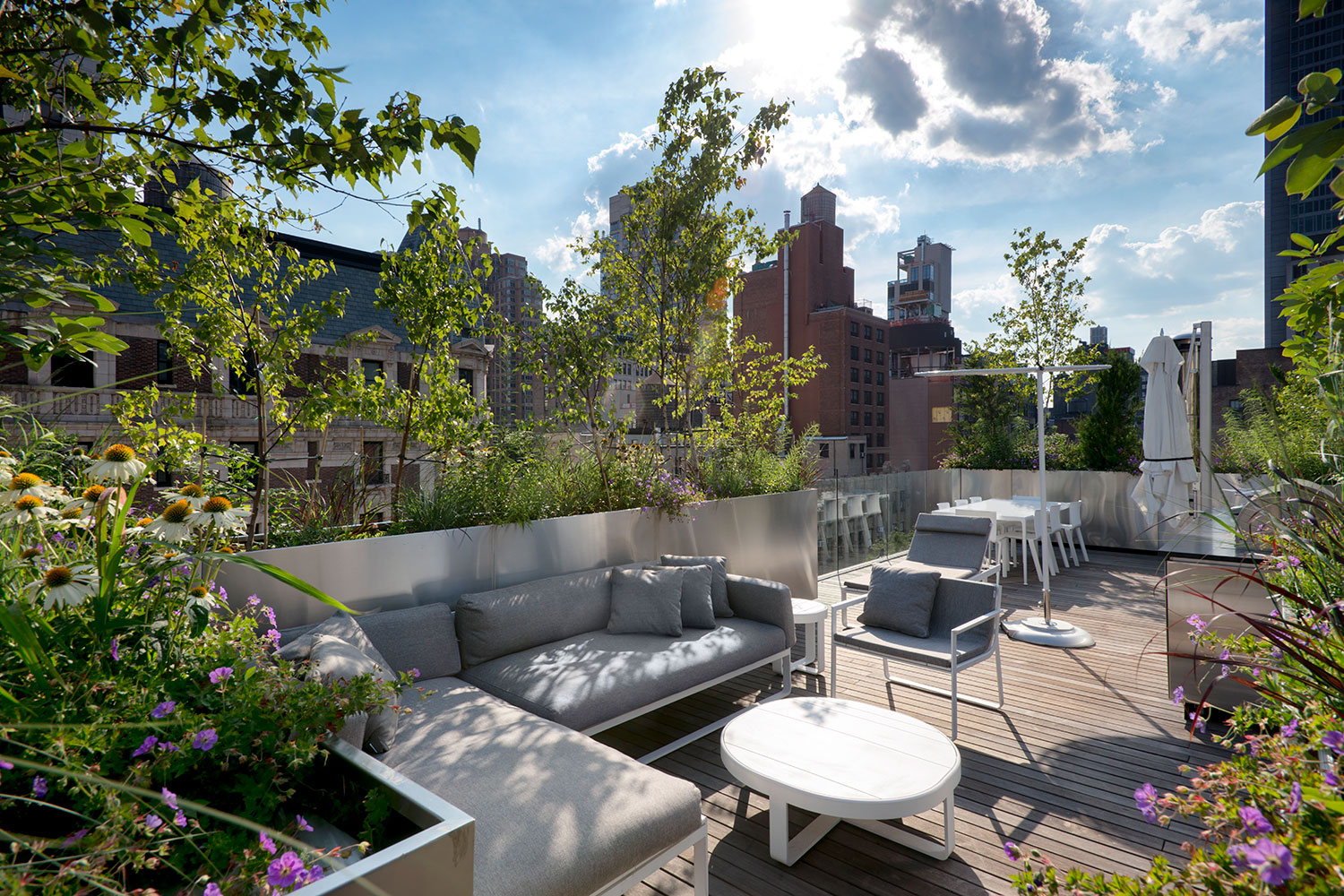Story at a glance:
- Green architecture and urbanism offer many tools for helping to combat climate change.
- Industrialization created the climate crisis and the contemporary city—and it’s essential to the solution.
- Cities still offer our greatest opportunity for a sustainable future.
We are in the midst of a revolution to fight climate change at every level—from homes to buildings to cities. The architect, planner, developer, agencies, and officials have many tools at their disposal—from energy infrastructure to transit systems to building technologies. But green architecture and urbanism offer a particularly effective range of options, including urban trees, rain gardens, and green networks. The constructed landscape and artificial nature are tools in this fight.
What is Artificial Nature?

Artificial nature is seen here at Halletts North. Rendering courtesy of STUDIO V Architecture
“Artificial nature” is not a contradiction. I don’t mean artificial in a pejorative sense—fake or false, less than nature. I mean real, green, growing, gorgeous nature in all its glory within our man-made environments: trees, parks, and public spaces. Today, in some ways, all nature is artificial. In the Anthropocene there is no unaltered nature. Everywhere on earth bears the marks of man, from the densest cities to the remotest regions.
Combining earth with artifice and nature with technology, we invoke park networks, urban forests, green architecture, and biophilic technology. Despite these concepts becoming embedded in our consciousness and co-opted in our language, the questions on how they are explored and explained remain.
The irony is that industrialization created both parts of this story—the climate crisis and the contemporary city. It contributed to the problem, and it’s essential to the solution. Industrialization created the technologies and tools, the cultural norms and lifestyles, and the improvements to health and humanity that raised our standards and lifespans. These same benefits led, tragically, to climate change. This same industrialization created the contemporary city in an explosion of urban growth from the 19th century continuing through today. Innovations in transportation, energy, and building technologies encouraged the expansion of human habitation at scales previously unthinkable.
But if modern technology forged the contemporary city, modern architecture originally attempted its assassination. Modernism’s misguided vision for the “radiant city” (“towers in the park!”) provided towers in the parking lot—and disinvestment in transit, highways carving through downtowns, red-lining, suburbanization, astonishingly destructive urban “renewal.” And also, tragically, climate change.
There is hope. Cities still offer our greatest opportunity for a sustainable future. Despite their flaws and failures, cities offer the greatest tools for reducing carbon use, expanding opportunity, education, and equity. If modern architecture was once the vehicle for the city’s near destruction, today it offers a catalyst for its rebirth. It’s making cities more green, sustainable, and human. The intersection of nature and artifice is the core of the contemporary city. The green revolution is embodied in the contradiction of reconstructed nature. How can it redress our failures and remake our cities?
How Can Artificial Nature Remake Our Cities?

Overall view of Halletts North. Rendering courtesy of STUDIO V Architecture
Artificial Forests
We require forests of urban trees. Every city in America should adopt a scaled version of NYC’s million tree program. Urban trees provide a canopy, and wildlife corridors, mitigate the heat island effect, and offer neglected communities greater social justice.
Constructed Earth
New York City’s 526 miles of waterfront comprises hundreds of acres of constructed “land.” Utilizing and manufacturing soil is central to artificial nature; reconstructed waterfront edges mitigate sea level rise, and composting for urban farming removes methane. Combined tree pits, use of structural soil, soft engineered edges, and conjoined plant networks encourage competition, biodiversity, and resiliency.
The New Natives
All plants were once native. Nature today is a curious conjoining of invasive, interloper, and adapter. We now tear out masquerading nature composed of invasives and replace them with reconstituted original natives. We also embrace new natives—pollution-tolerant, saltwater-tolerant, and modern disease and invasive insect-tolerant plants, adapted to the modern conditions and the nature we have irrevocably altered, offering bioremediation, resiliency, and biodiversity.
Restoring Rain
All gardens were once rain gardens. Today rainwater is trapped and diverted into sewers, dumped into rivers, and overwhelming sewage treatment plants forcing outflows of raw sewage. Rain gardens recharge aquifers, create diverse riparian environments, assist resiliency, and alleviate combined sewer outflows.
Sky Gardens

View of rooftop and bridge at Empire Stores. Photo by K. Taro Hashimura
If home is where the heart is, then ground is where you make it. Nearly all modern ground is artificial; every surface manipulated. The artificial ground offers spectacular and creative opportunities for precious open space to sustain and humanize dense urban environments. Future parks are being elevated on buildings and former infrastructure, threaded through elevated highways, and perched above waterfronts creating gardens in the sky.
Where does the green revolution go from here? Some speak of retreat: abandoning waterfronts, leaving the city behind for the country.
To address these doubts, I invoke American landscape architect Frederick Law Olmsted. Looking upon his work, many incorrectly assume Olmsted preserved pristine landscapes around which vast cities sprang up. But Olmstedian nature is all artifice. Central Park is a brilliant artificially constructed green tapestry that radically transformed its difficult site. Prospect Park is all constructed views, manufactured experiences intermixed with artificial lakes and waterfalls. Buffalo’s interconnected parks and parkways offered the world’s first network of artificial nature.
We can’t ignore climate change. There’s no “metaverse” in which to hide. And two things remain sure. The solution must embrace the reconstruction of living nature within the living city. And there is no do-over.




